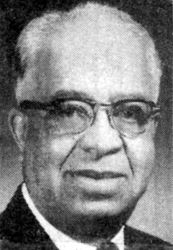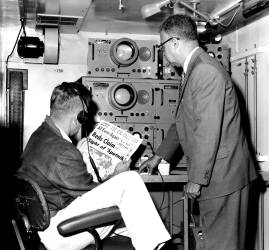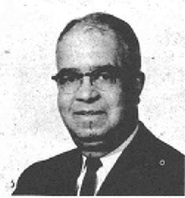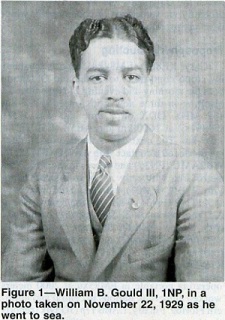
|
William B. Gould Long Branch, NJ QCWA # 2217 OOTC # 0190 |
Born on March 14, 1902, young William B. Gould III (Bill) would have his first 2-way radio contact at the age of 13 using a buzzer as a transmitter. He used the call WG. Later in 1919 at the age of 17, he would pass his Amateur Radio test and be issued the call 1NP. His license authorized him to transmit spark not exceeding 500 watts into an antenna with a single lead-in wire, an "L" shaped antenna 30 feet high, 50 feet long and made up of 6 wires. He was very active on ham radio from the beginning, contacting stations all the time.
 Enrolled in college at the Worcester Polytechnic Institute (WPI). This was in 1920 or 1921. WPI was the third college in the country with a wireless club, starting in 1909 and used the call letters WPI. In 1913 the government issued the call 1YK and required that only licensed operators would be able use the station. The Wireless Association immediately started radio classes for the students. On the air almost every day, it's logical that Bill would have been in frequent communications with 1YK at WPI and would have made many friends there.
Enrolled in college at the Worcester Polytechnic Institute (WPI). This was in 1920 or 1921. WPI was the third college in the country with a wireless club, starting in 1909 and used the call letters WPI. In 1913 the government issued the call 1YK and required that only licensed operators would be able use the station. The Wireless Association immediately started radio classes for the students. On the air almost every day, it's logical that Bill would have been in frequent communications with 1YK at WPI and would have made many friends there.
The 1922 Trans-Atlantic Tests at WPI
Under Bill's leadership in December of 1922, 1YK was invited to participate in the Trans-Atlantic Tests. The WPI Wireless Association had been experimenting with their antennas during that year, and had qualified earlier with their 50-watt transmitter, being heard clearly in the Mississippi valley.
During the December 1921 tests, Godley heard 1YK in Scotland. This came somewhat as a surprise to the Wireless Association, as they were only using 20 watts at the time. They later attributed their success to the experimental antenna system they were using.
A Career in Radio
 By 1922 Bill had a "Radio Operator, Commercial First Class" license, as he was the "Chief Operator" at 1YK for the years 1922 and 1924; this was a requirement.
By 1922 Bill had a "Radio Operator, Commercial First Class" license, as he was the "Chief Operator" at 1YK for the years 1922 and 1924; this was a requirement.
Bill's first job after college was as Engineer with Worcester's radio station WTAG, this was from 1925 to 1929. During this time he also enlisted in the U. S. Naval Reserve as a Radioman. He served there on the USS Eagle.
In 1929 he followed the path of so many other young radio operators, that of going to sea. His first assignment was on the SS Edith, a coastal steamer that also traveled to the Caribbean. He stayed here until December 1930. He also served for a short time on the SS Gov. John Lind in 1931.
He remained active with the Naval Reserve for a couple more years, attaining the rank of Chief Radioman.
His next big job was with the Metropolitan District Police Radio in Boston 1936-1940. He was instrumental in setting up the communications system for the Boston Police.
In 1940 he moved his family to New Jersey, where he was to begin a long career in the government, with the Signal Corps Labs in Fort Monmouth, N.J. He worked on the Army's first radars and supervised the design and development of the first weather radar equipment. It was here he would come to work with Dr. Harold Zahl. Dr. Zahl was the Director of Research from 1948 to 1966 at Fort Monmouth's Camp Evans.
October 4, 1957
Sputnik was put into orbit by the Soviet Union. Dr. Zahl was awakened by a telephone call from co-workers Hans Ziegler and Bill Stroud. Hearing the news Zahl joined them for a ride to the home of Edward Rich in Farmingdale, NJ. There on a Collins R-390 they heard the "beep-beeps", as they called them, for the first time. They listened all night, calling their team one by one, until all were alerted. Those who were hams, as did Bill, ran to their stations and listened.
 The next day the entire team was in place, tracking the satellite for the government. Dr. Zahl would later say, "But perhaps most important of all during these early hours on October 5 were the efforts of a few of our Countermeasures people operating an experimental direction finding station at Collingswood, N. J. In the open, and in freezing weather, Bill Gould, Harold Jaffe and associates, day after day, all through the long nights, week after week, gave out bearing information-information vitally needed by the Vanguard Computing Center at NRL to determine orbits and make predictions. Yet, the Soviet had kicked off, but before we could really play in the game, we first had to find the ball."
The next day the entire team was in place, tracking the satellite for the government. Dr. Zahl would later say, "But perhaps most important of all during these early hours on October 5 were the efforts of a few of our Countermeasures people operating an experimental direction finding station at Collingswood, N. J. In the open, and in freezing weather, Bill Gould, Harold Jaffe and associates, day after day, all through the long nights, week after week, gave out bearing information-information vitally needed by the Vanguard Computing Center at NRL to determine orbits and make predictions. Yet, the Soviet had kicked off, but before we could really play in the game, we first had to find the ball."
Retiring to Ham Radio
Bill's calls changed over the years. 1NP became W1NP. Eventually after moving to NJ he changed it to K2NP. Retiring in 1969, Bill and his wife Leah enjoyed many trips around the country and around the world. They would always find time to visit ham radio friends, friends that were made on the air. Bill continued to be on the air and active with many organizations including: ARRL, Life Member IEEE, a director and vice president of the Old Old Timers Club, a member of the Quarter Century Wireless Association, and the Antique Wireless Association where he was a close friend of founder Bruce Kelley, W2ICE. Bill remained active and on the air until the end. He became a SK on August.15, 1983.
William B. Gould III, Radar, Radio Expert
His obituary would read: "William Benjamin Gould III, now deceased, was also one of the early Black electronic engineers at Fort Monmouth. Coming to Fort Monmouth in 1940, he was responsible for the installation and operation of early warning radar systems on the West Coast of the U.S. During the 1950s, Mr. Gould directed research-involving instrumentation of long-range guided missiles at Cape Canaveral. Before his retirement in 1969 he was a section chief in the Electronic Warfare Laboratory, directing research and development involving the application of radio and radar for meteorological purposes. During his 29-year career he contributed to the development of radar equipment from the old spark gap transmitter to the vacuum tube and the modern solid state devices."

